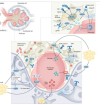Regeneration Bonus: Ann Morris
To study cell regeneration in the eye, Ann Morris’s vertebrate of choice is Zebrafish, a minnow-like freshwater fish with the same type of retinal cells as other vertebrates—including humans.
Morris says, “When something happens to our neurons, either in your brain or in your retina, if the neurons die they can’t be replaced. Now unlike mammals, zebrafish are able to regenerate neurons after injury or disease. And so we want to understand what are the genes that you need to replace those neurons, how is it that those neurons are able to be remade. And if we can understand that, then we may be able to inform efforts to try to develop therapeutic approaches to treat retinal degenerative diseases in humans.
“With zebrafish the embryos develop outside the mother, and they are completely transparent. And development occurs very rapidly. So we can study the process of the development of eye under the light microscope in a dish, and it only takes a couple days to happen.
“The genome of the zebrafish has been sequenced. So we know the DNA sequence of all of the genes even if we don’t know what their function is.”
How is it that zebrafish can regenerate retinal cells and we can't? Morris says the answer is suspended between two distinct possibilities. “One is that everybody had the ability to regenerate, and that ability in certain lineages was eventually lost. So as mammals evolved somehow they lost the ability to regenerate neurons, but perhaps all the mechanism is still there, in their genome, so we need to find those switches and turn it back on.
“The other possibility though is that certain vertebrates evolved that ability whereas others didn’t. And so it’s possible that mammals can’t regenerate neurons because they just don’t have that mechanism. I happen to believe it’s probably more of the former, that some of those abilities are there and they’re latent and we have to discover how to reactivate them.
“It’s possible that in sort of evolving this more advanced immune system, in order to be able to heal rapidly, mammals had to give up that ability to regenerate. So what we see in the retina of mammals, when there is degeneration, is that there is a certain cell type, the glial cell, which is one of the supporting cells of the retina. It gets activated to quickly form what’s called a glial scar. And that sort of seals off the retina from further damage. But in doing that, it’s basically preventing any possibility of regeneration. And what we see in fish is that this glial scarring doesn’t happen. They have the exact same cells. So it may just be a matter of figuring out the differences between the pathways that are being activated in just those couple of cells.
“When you’re remaking neurons what you’re doing is your taking a tissue that is already present, a circuit if you want to make that analogy, that’s already existing and you’re asking for cells to be remade and to somehow integrate themselves into an already existing circuit. So it’s not just a question of remaking the cells, but also getting them to connect up to the right partners, and migrate to the right position and find the proper place.”
Learn more about the unofficial regeneration “cluster” of researchers at UK.


